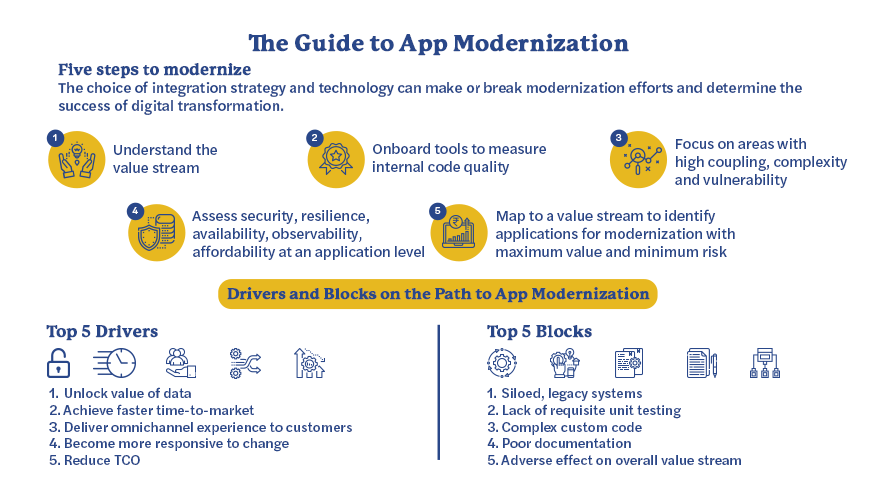
Modernizing mission-critical legacy system architectures and unlocking value across siloed processes are the top priorities for every business, but they are also complex undertakings. Done well, application modernization can support a broader digital transformation strategy for building a nimbler, customer-centric, and data-driven business that allows data to traverse legacy, current, and future systems.
Though most organizations already have considerable on-premises integration capabilities, their applications on cloud often exist in silos, and thus leaving data more fragmented across the enterprise. Modernization efforts are most effective when it allows organizations to expand their reach beyond silos and collect, compare and contrast vast amounts of data to discover patterns, relationships, and insights that were previously too expensive or time-consuming to produce.
That is where we’re seeing the big shift.
Modernizing legacy applications
Banks and financial services companies are facing a lot of pressure to be able to deliver new services more rapidly. Customers want an omnichannel experience and they want to have access to relevant data anywhere and anytime.
From the perspective of large organizations, much of that data is locked in legacy applications, which were developed over the years using a variety of different proprietary platforms, languages and tools. Now, not only does that data have to be unlocked and delivered to customers who might be accessing that information from a variety of channels, but the data must also be presented in a way that it leads to personalized and insightful experiences.
How do we do that?
Regardless of the industry, organization or technology, one of the fastest paths to modernization and delivering value to the customer is to build a robust and flexible integration layer which can capture, analyze and recall the data relevant to the customer from across multiple sources and deliver it across multiple channels.
We have several years of experience of working with banking and financial services clients, and we understand how the best-of-breed technologies at any point in time can be integrated and retrofitted with modern frameworks, toolsets and approaches. We also understand the traditional integration paradigms and can reverse-engineer integration solutions to drive greater value, agility and speed required for application modernization.
The traditional approach where organizations had to figure out and develop APIs (application programming interfaces) and point-to-point integration from scratch each time, severely limits the ability of organizations to scale out and tap into the broader digital ecosystem within and outside the organization. As a result, integration across the digital ecosystem is now a first-order design consideration for organizations, and not an afterthought which can be addressed later.
COVID push to the cloud
The speed and scale of the COVID-19 disruption caught everyone unawares. Post-COVID, anything with any sort of physical dependency will be seen as a liability, and organizations which traditionally preferred to have complete control of their IT infrastructure, are now realizing that it’s probably not going to be a viable approach in the future. Invariably, many of these organizations are now looking to migrate their workloads to the cloud and adopt a NoOps model.
However, while moving to cloud, organizations have to now deal with a paradigm shift to understand how development and operations will impact data ownership, security and integration. Taking a lift-and-shift approach to cloud for distributed real-time applications, is not cost-effective in the long run. While organizations are prudent to adopt microservices and iPaaS (integration platform as a service), they also have to think about the operational metrics which are tied to business objectives.
Where do you begin?
Businesses today want to make data-driven decisions and capture insights from data stashed in legacy systems. One of the most common challenges faced by chief technology officers (CTOs) during transition to cloud and microservices is that, as applications age, it becomes very expensive to maintain custom code, which is often complex, brittle and poorly documented. The constraints, dependencies, assumptions that went into the design decisions are often obscure as many legacy applications did not have much emphasis on unit testing or code coverage — those standard engineering practices that we take for granted today.
The biggest challenge we face in dealing with modernizing legacy applications is that these don’t have the requisite level of transparency or confidence. A minor change in one part of the system could potentially trigger a major outage in other systems which are integrated with it.
A good place to start is with the team which is closest to the legacy applications who not only understand the internals of the application, but also know how the applications are integrated across the value stream. The next step is to introduce tools which can continuously measure internal code quality and provide timely feedback on areas which have high coupling, high complexity and potential security vulnerabilities. Finally, after considering cross-cutting concerns such as security, resilience, observability, availability, accessibility and affordability at an application level, you could map it to a value stream perspective and ascertain where you could derive most value, and minimize the risks that might arise from modernizing an application.
Key takeaways
Organizations should continue to leverage their existing integration investments.
The adoption of cloud combined with the need for organizations to become more digital and user-centric, means that data is not only becoming more and more federated, but accessing it in real time and from virtually anywhere is an absolute must.
Application modernization for the cloud calls for a well-thought-out and balanced strategy to deal with the governance, security and compliance challenges.
As organizations prepare to move workloads to cloud, it is important to avoid a one-size-fits-all approach and take a bottom-up approach.
Contact
Our experts can help you find the right solutions to meet your needs.
Get in touch
